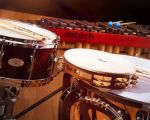- 1-Best Synths Overview
- 2-Types of Synthesizers and Their Uses
- 3-Features to Consider When Choosing a Synth
- 4-Top Synthesizers in 2025 for Electronic Music Production
- 5-Real-World Examples and User Experiences
- 6-Where to Find the Best Synthesizers and Resources
1. Overview of Synthesizers in Electronic Music Production
When diving into electronic music production, choosing the right synthesizer is crucial. Synthesizers are more than just instruments; they are powerful sound design tools that shape the character of your music. Whether you're crafting pulsating basslines, ethereal pads, or aggressive leads, the best synthesizers can dramatically influence your creative workflow and final sound. For producers of all skill levels, understanding how to select and utilize synthesizers effectively can unlock new dimensions in music creation.
1.1 The Role of Synthesizers in Modern Electronic Music
Synthesizers have evolved immensely since their inception. Today, they range from vintage analog models revered for their warm tones to cutting-edge digital synths offering vast sonic flexibility. In electronic music, synthesizers often serve as the foundation of your track’s texture, providing everything from rhythmic sequences to atmospheric layers. Integrating the right synth into your studio setup can elevate your productions from ordinary to extraordinary.
1.2 Why Focus on the Best Synthesizers?
Not all synthesizers are created equal. The “best synthesizers” for electronic music production strike a balance between sound quality, versatility, ease of use, and affordability. Investing time and resources into selecting the right synth can improve your creative output and workflow efficiency, enabling you to experiment and refine your unique sound. This article breaks down essential factors and highlights top models to guide you in making an informed choice.
2. Types of Synthesizers and Their Uses in Electronic Music
Understanding the types of synthesizers available is fundamental. Synths are generally categorized into analog, digital, hybrid, and modular formats, each with distinct sonic characteristics and workflow implications.
2.1 Analog Synthesizers
Analog synthesizers generate sound through continuous electrical signals, prized for their warm, rich tones and organic feel. Iconic models like the Roland Juno-106 or Moog Minimoog have shaped countless electronic tracks. Analog synths excel at producing thick basses and creamy leads but often lack the presets and recall features of digital models.
2.2 Digital Synthesizers
Digital synths rely on digital signal processing, offering immense versatility and a wide palette of sounds. They can emulate analog textures while providing complex modulation options, effects, and patch storage. Popular digital synths like the Korg Wavestate or Yamaha MODX appeal to producers who need both flexibility and portability.
2.3 Hybrid Synthesizers
Hybrid synths combine analog signal paths with digital control or wavetable oscillators, giving producers the best of both worlds. These synths offer classic warmth alongside modern sound design capabilities, making them particularly suited for electronic music producers aiming for innovation without losing character.
2.4 Modular Synthesizers
Modular synthesizers represent a customizable approach, where users patch together individual modules to create bespoke sounds. While they have a steeper learning curve, modular synths offer unparalleled creative freedom and have seen a resurgence in electronic music, especially among sound designers and experimental producers.
3. Key Features to Consider When Choosing a Synthesizer
Beyond the type, several critical features influence a synthesizer’s suitability for electronic music production:
3.1 Sound Engine and Oscillators
The heart of any synth is its sound engine. Whether analog or digital, the number and type of oscillators determine the tonal possibilities. Producers looking for complex textures may prefer synths with multiple oscillator types (sine, saw, square, wavetable), while others might prioritize simpler, raw analog waveforms.
3.2 Modulation Capabilities
Modulation options like LFOs, envelopes, and step sequencers expand your ability to create evolving sounds. The more flexible and intuitive these are, the easier it becomes to design dynamic patches that breathe life into your tracks.
3.3 User Interface and Workflow
For many, the interface is make-or-break. A synth with a clear layout, responsive controls, and immediate feedback encourages experimentation and helps avoid frustration. Some synths feature hands-on knobs and sliders, while others rely on menus and screens—both can be powerful, but user preference varies.
3.4 Connectivity and Integration
Modern studios often include multiple devices. Look for MIDI compatibility, USB connectivity, CV/Gate inputs, and DAW integration features. These ensure your synth fits smoothly into your setup, whether you’re working in hardware or hybrid environments.
3.5 Portability and Build Quality
If you perform live or travel, portability matters. Lightweight, durable synths with battery options can make a significant difference. Meanwhile, solid build quality ensures longevity, especially for hardware frequently transported or used in demanding setups.
4. Top Synthesizers in 2025 for Electronic Music Production
Based on the latest trends and user feedback, here are some of the best synthesizers shaping the electronic music landscape in 2025:
4.1 Moog Subsequent 37
Moog’s Subsequent 37 remains a favorite for analog enthusiasts. Its rich, fat sound and powerful modulation matrix make it perfect for bass-heavy electronic genres. Artists appreciate its hands-on control, which inspires real-time tweaking during studio sessions and live performances.
4.2 Korg Wavestate
The Korg Wavestate is a digital synth that excels in wavetable synthesis and complex sequencing. Its deep sound design capabilities allow electronic producers to craft evolving textures and rhythmic patterns rarely found in other synths. It’s especially praised for cinematic soundscapes and experimental electronic music.
4.3 Dave Smith Instruments Prophet Rev2
The Prophet Rev2 is a hybrid powerhouse with dual digital oscillators and analog filters, delivering a wide tonal palette. Its polyphonic capabilities and extensive modulation options make it a go-to for lush pads, aggressive leads, and complex sequences, ideal for electronic producers looking for versatility.
4.4 Arturia MicroFreak
Arturia’s MicroFreak blends digital oscillators with an analog filter, wrapped in a compact and affordable package. It’s excellent for producers on a budget who want access to unusual sounds and experimental synthesis, proving that creativity doesn’t always require breaking the bank.
5. Real-World Examples and User Experiences
Understanding how synths perform in real scenarios can help shape your choice. For instance, the Grammy-winning producer Flying Lotus credits the Moog Subsequent 37 for contributing to his signature analog warmth and gritty textures. On the other hand, electronic duo ODESZA frequently incorporate the Korg Wavestate in their live setups to create lush, evolving soundscapes that captivate audiences.
In online producer communities, users highlight how the Arturia MicroFreak sparks creativity by encouraging sonic experimentation without overwhelming complexity. These personal anecdotes emphasize that beyond specs, the best synthesizer is one that fits your workflow and sparks inspiration.
6. Where to Find the Best Synthesizers and Related Resources
For those ready to explore and acquire top synthesizers, visiting specialized platforms like Beat Trigger can make all the difference. Beat Trigger offers curated recommendations and connects you to the best deals on gear tailored for electronic music production. Their expert insights and product reviews help streamline the search for synthesizers that suit your style and budget.
Additionally, Beat Trigger provides valuable resources including tutorials, gear comparisons, and community forums that support producers at every stage, making it a one-stop hub for enhancing your music production journey.








